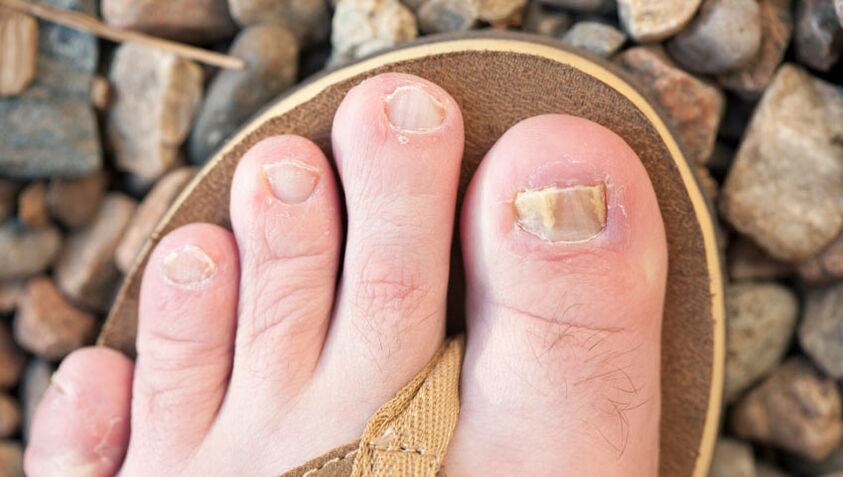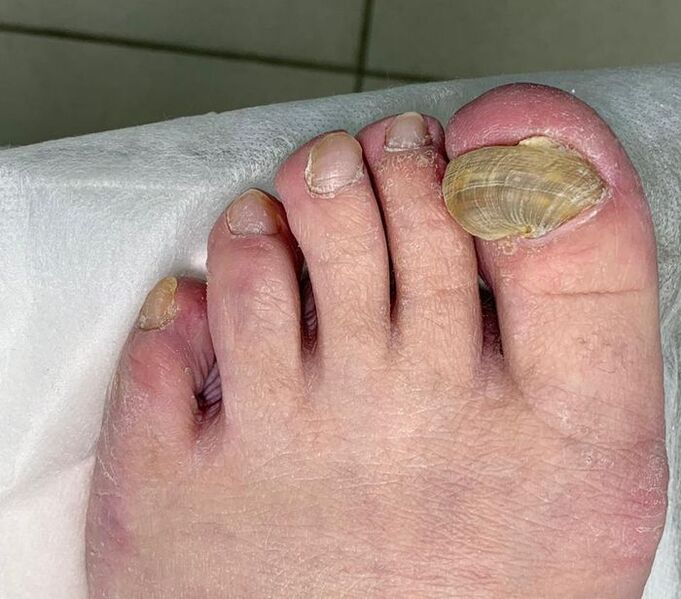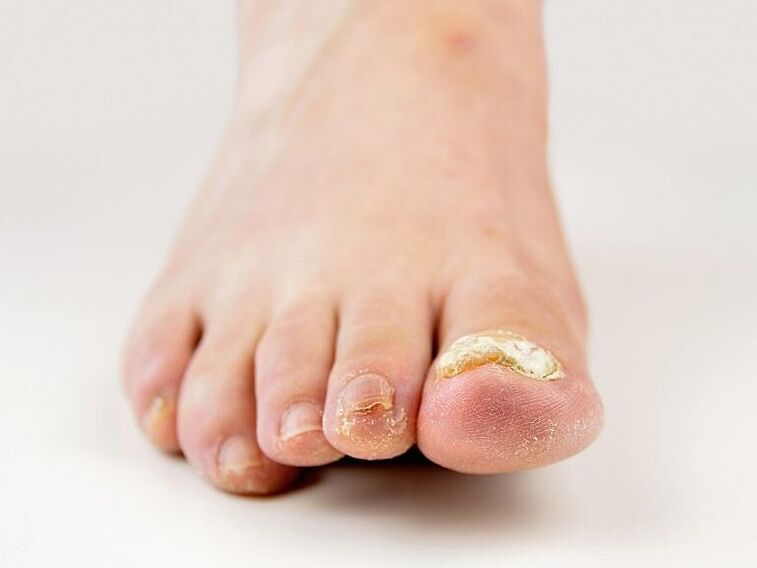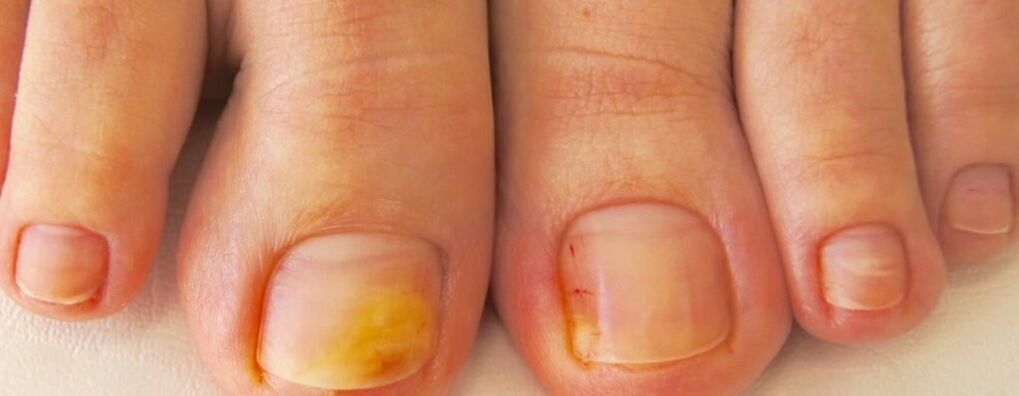Nail fungus is a dermatological disease that affects more than 20% of humanity and not only causes aesthetic damage, but can also cause health and immunity problems in humans.
It is characterized by a change in the color of the nail plate, its deformation and crumbling, in medicine this pathology is called onychomycosis. An infection occurs when a fungus of the dermatophyte class gets under a healthy nail. It multiplies rapidly, damaging the soft tissues and forming spots on the nails of white and yellow color, which further causes deformation and death of the nail. When a nail is affected, with untimely treatment, the fungus is transferred to healthy surfaces. All this brings considerable discomfort to a person's life. In this article we will understand the causes, symptoms, how to cure such a fungus and, most importantly, how to avoid this unpleasant disease.
Causes of nail fungus
The main reason for the appearance of the fungus is a weak human immune system. When the protective functions of the body do not work well, the risk of infection from infections, viruses and bacteria increases significantly. A fungus on the toes appears more often than on the hands, due to high humidity and lack of necessary air circulation.
Also at high risk are:
- People with poor hygiene. Do not allow intense sweating of the feet, wet and dirty socks, walk barefoot without slippers;
- People with pathologies of internal organs and blood vessels, carriers of HIV. Diabetes mellitus and blood clots in the veins cause poor blood circulation in the legs;
- People who ignore tight and uncomfortable shoes. Even minor corns, microcracks and calluses on the feet can cause a fungus infection;
- People in the period of hormonal changes in the body, the elderly;
- People are trying on shoes in stores without disposable socks. After all, there is a danger that someone infected with a fungus has tried these shoes before you.
Fungal infections love moist, warm environments, as well as open wounds and abrasions where they can multiply instantly.
Public places such as hotels, gymnasiums, swimming pools, locker rooms, showers and saunas are the preferred home for fungal infections. If a person likes to walk there barefoot, the risk of infection is one hundred percent. It should be remembered that fungal infections are contagious and are easily transmitted in the home or through contact with a person.
Stages and Symptoms of Fungus
Alas, the fungus is a rapidly growing infection. Like the roots of a tree, it grows under a person's skin, destroying tissues and surfaces. Usually the fungus begins its activity with the little finger or the thumb, eventually affecting all the nails.
In general, there are initial, moderate and advanced stages, but the evolution of the disease will be understood a little more using medical terms:
- Stage of infection - the fungus clings to the dead scales of the skin and eventually works its way up to the nail plate. Has no symptoms;
- Normotrophic stage - the natural color of the nail fades and turns yellow at the edges, thickening towards the corners. Small streaks or white dots may appear. There is a specific smell and a feeling of discomfort;
- Hypertrophic stage - the nail becomes completely yellow, deformed, the surface is messy and ribbed. In most cases, the entire nail plate thickens, and the edge itself peels off and exfoliates;
- Atrophic stage - dull yellow or gray nails. Pieces of the nail fall out, the nail bed has an unhealthy appearance, a loose surface;
- Stage - onycholysis - the entire nail plate becomes very thin and subsequently disappears. The fungus can move to neighboring nails that are still healthy.
The skin around the nail itself is usually red and scaly. The patient notes itching between the fingers, cracks are observed, accompanied by pain. Often, at the last stage, the fungus, penetrating into the nail bed, dies under the influence of immunity. But if the protective functions of the body are weakened or treatment is not carried out, blood poisoning may occur.
Types of mushrooms
The most popular among the causative agents of onychomycosis are fungi - dermatophytes. They affect more than 85% of infections. And, therefore, Candida (yeast) class fungi and molds are much less common among pathogens. Also, sometimes there are cases of nail infection with several types at once.
Let's take a closer look at each type.
Fungi Dermatophytes
There are several types of this fungus. They are popular because they can adapt to any microclimate. Living in the ground cover of the earth, can easily infect animals and humans through direct contact on the surface, as well as the "carrier and infected" relationship. However, this type of infection rarely occurs and the disease is usually preceded by several factors.
The most well-known types of dermatophytes:
- Trichophyton rubrum - first infects the tip of the nail, then gently reaches the base. The nail breaks down, becomes yellow, thick and lethargic. The surrounding skin is unusually dry, red and scaly;
- Trichophyton mentagrophytes is the main lover of a humid and warm microclimate. They are usually infected in public places, such as showers, swimming pools and saunas. Often causes damage to the big toes and surrounding area. The skin becomes inflamed, itchy and inflamed bumps form.
It is difficult to cure a fungus that has managed to get to the base of the nail plate. In this case, most likely there will be a complete loss of it.
Candid Mushroom
Yeast or Candida is present in normal amounts in the body of all people but, under a number of triggers, can multiply rapidly and cause disease.
Especially familiar to women. Because a large part of them have had to deal with a disease such as thrush during their lifetime, caused by this particular type of Candida class fungus.
In cases where Candida appeared on the nails, it can be safely assumed that the infection occurred in a domestic way, through some thing that the infected person had previously used (towel, washcloth, shoes). And it forms, unlike dermatophytes, initially at the base and is most often found on the nails of the hands.
mold fungi
The most dangerous type of fungus. It is able to harm not only the skin, but also quickly affect the whole body.
Infection occurs due to destruction of the nail, exposure of the nail bed. The good news is that infection with this type of fungus occurs in extremely rare cases. But if it still happened, it is very difficult to treat it with conventional drugs and requires special remedies for fungus on the nails.
Diagnostic
Since the external symptoms of nail fungus can resemble other diseases (such as lichen, psoriasis, keratoderma), in order to confirm the diagnosis of fungal infection and determine the pathogen, the doctorprescribed such studies:
- Microscopy of the nail plate - the laboratory assistant makes a scraper from the nail and treats it with a special substance to destroy keratin. This procedure is necessary for easier and more accurate observation under the microscope. There is also a downside to this analysis. With its help, it is impossible to determine the type of pathogenic fungus. Based on the results obtained, antimycotics with extended action are prescribed;
- Type of cultural study - in the laboratory, the material obtained from the scraping of the nail is immersed for culture in the Sabouraud nutrient medium, where the fungus grows rapidly. The fungus is determined by the growth rate, color and shape of its colonies. In addition, using this method, the sensitivity of antibodies to drug treatment is determined. The disadvantage is that the result of the analysis must be waited for 3-5 days;
- The purpose of DNA diagnostics - nail scrapings are studied for the presence of DNA cells of fungal infections of the class of dermatophytes or yeasts. The most dangerous type of mold cannot be determined by this method. The diagnostic result is ready after 1-2 days, and the disadvantage is the high price of the method due to the use of special devices.
Treatment methods
If you are wondering which doctor to contact for such a disease, there is only one answer - you need a dermatologist.
At the initial stage, if it was possible to immediately identify the infection, external treatment will be sufficient. But if the infection was not detected immediately, and the visit to the doctor was postponed for a long time, complex therapy of a more serious nature will be required. In especially severe cases of the disease, the nail plate is removed. Sometimes treatment is delayed for six months, in order to avoid this, we strongly recommend that you pay attention to disturbing symptoms in a timely manner and immediately seek help from specialists.
The type of treatment you need will be determined by the diagnosis, as it is important to determine which fungus the infection has occurred. Drugs in the treatment of nail fungus are divided into 2 groups:
- Locally acting preparations - this group includes therapeutic ointments, creams, varnishes and gels. They are usually used at the initial stage of treatment, when the disease was detected in time;
- Antimycotics are antifungal drugs with a systemic effect, which are used orally. Available in the form of tablets and capsules which can eliminate the activity of the fungus. They have the ability to block the spread of mycosis, have a long-lasting effect, which again prevents the onset of the disease.
These groups of drugs can be prescribed individually or can be means of complex therapy, depending on the nature and severity of the infection.
Doctors also give additional recommendations:
- Use only personal hygiene products and household items (washcloth, towel, dishes, etc. );
- Follow a personal diet prescribed by a physician;
- Process and air shoes so that during processing the fungus does not create a favorable environment for reproduction;
- Be sure to take vitamin complexes to strengthen the immune system. during and after treatment.
Antifungal ointments
In the treatment of nail fungus, it is important to use topical preparations, only in cases where the lesion is not severe and occupies less than half of the nail plate. Or in case of individual intolerance to the components of systemic drugs. After all, drugs such as antifungal ointments do not penetrate the tissues sufficiently and therefore do not have the ability to effectively and completely cure a person. But as an additional therapy for the relief of external symptoms and prevention, they are excellent.
It must be remembered that to begin with, the affected part of the nail is cut, then not only the nail, but also the soft tissues, the areas around it should be treated with ointment.
Local therapy will be effective with the participation of such remedies for nail fungus:
- Hypoallergenic drug with minimal side effects, well tolerated by the body. The composition contains a non-toxic component such as a polyene antibiotic (a group of tetraene polyenes). The ointment is applied in a thin layer to the affected areas, usually as a course of 2 to 4 weeks, depending on the stage of the disease;
- A preparation capable of penetrating deep into the skin has a storage effect. Also use in a thin layer, on the dry areas concerned. The course lasts at least two months.
Special varnishes
Nail polishes for nail fungus are the most convenient means to use, but are also suitable only in the early stages of fungal infection. You need to use them only two to three times a week, applying them to the affected nails. Here are examples of proven and effective varnishes:
- The active component of varnish is a derivative of morpholine, which can quickly destroy up to 10 types of infectious agents, destroying them at the cellular level. The drug is applied, pre-moistening the nails, in a course until complete remission;
- The active substance of varnish is able to exterminate 58 types of fungal pathogens. The course of treatment is 3 months, with a gradual decrease in the frequency of use per week (in the first month, the varnish is applied every other day, then twice a week, and at the last stage only once a week).
ethnosciences
Folk remedies cope well with the symptoms of fungal infections, but they work only in combination with drugs.
There are many natural components, natural remedies and treatment methods that do not require large expenditures. It can be a variety of herbs, potassium permanganate, iodine and vinegar for baths, solutions, tea tree and eucalyptus oils. But since nail fungus is a complex and long-lasting disease, it also requires the approval of your dermatologist. After all, there is a big risk of allowing complications and then losing the nail completely and forever.
Often, to relieve symptoms, the following alternative methods are recommended:
- Rub the garlic on the affected areas of the nails;
- Soar your feet in the water with washing powder;
- Baking soda lotions, diluted with water (to a thick consistency and apply to the nail for 20 minutes, then rinse with warm water);
- Invest in socks such as: nettle, mint, chamomile, sage, propolis (change the contents of the socks daily).
We will get to know the rest of the folk methods in more detail below.
Vinegar baths
Vinegar baths are one of the best folk remedies for nail fungus.
Apple cider vinegar and wine vinegar are suitable for recipes. At the same time, it is important to observe the correct proportions and use only a natural product, without any chemical additives.
- Recipe #1: Soak your feet once or twice with water mixed with apple cider vinegar in a one to one ratio. The duration of the procedure is about 20 minutes, and it is better to stretch the treatment for 2 weeks with daily baths.
- Recipe number 2: Dilute 5 tablespoons of 9% wine vinegar in 2 liters of hot water. Spray your feet for at least 30 minutes, then clean the softened stratum corneum from the nail plate with a stick. After that, it is recommended to immediately apply an antifungal agent. Stretch the course of the procedure for a month, using baths daily and preferably 2 times a day.
tea tree oil
An effective antifungal agent obtained by pressing the oil from the leaves of the tea tree. It is used by the whole world for the treatment of other pathologies, in the form of acne, scratches and abrasions. Recommended for use in the following ways:
- Spray your legs and lubricate the affected area of skin and nails with tea tree oil in the amount of five to ten drops, using a cotton swab. It is not necessary to rinse. The course of the procedure: 3 times a day, for at least two weeks;
- Add 5-10 drops of oil to a liter of warm water and keep your feet in such a bath for about half an hour. The course can last 2 months.
Tea tree oil is not recommended for pregnant women.
Iodine treatment
The most famous and cheapest method recommended by dermatologists around the world. The secret of this tool is that iodine has the ability to fold proteins. And as we know, pathogens have a protein structure, because they feed on keratin - a type of fibrillar protein.
How to treat feet with iodine?
- Method number 1:
Apply a drop of 5% iodine solution to the affected nail twice a day and once a day to the adjacent healthy nails. After about a week, a painful sensation in the form of a burning sensation will appear, this means that the destruction of fungal pathogens has begun. The duration of treatment may exceed one month, until complete recovery;
- Method number 2:
Steam your feet in a bath of hot water, soda and salt for 30 minutes (1 liter of water, 1 tablespoon of soda, 2 tablespoons of salt). Remove keratinized areas with scissors and dry your feet. Then apply 3 coats of iodine solution to each affected area of the nail (apply 1 coat, wait for it to dry completely and apply the next one). The course of the procedure: 1 time per day for a month.
Children can be exposed to nail fungus
As you may have guessed, such a disease as nail fungus can develop not only in adults, but also in children.
Children can pick up the causative agent of the fungus anywhere. Getting infected through contact with someone who is already infected, through a household case of poor hygiene, which we looked at above, or through injury with dirt getting into the wound, which can later develop asan infection.
In children, nail fungus can easily affect one or more fingers and toes. The first symptoms appear as small white or yellow spots on the nail. The infection may occur slowly, eventually spreading to the entire nail and completely changing its color. In addition, there is a deformation of the nail plate and crumbling of the nail, accompanied by unbearable pain.
Symptoms of nail fungus in children
Let's take a closer look at the symptoms of nail fungus in children:
- There is a thickening of the nail plate;
- Deformation of the nail, accompanied by its fragility;
- In appearance, the nails become dull, weak, without natural shine;
- If the fungus actively develops its vital activity under the nail, the nail plate may turn dirty brown, green or yellow;
- With complications of the disease, an unpleasant odor emanates from the nail.
Causes of nail fungus in children
The cause of infection, as in adults, lies primarily in the defeat of parasites - dermatophyte fungi. This type of fungus likes warm, humid environments and is found in large numbers in public places such as showers, baths, and swimming pools, where it is easy to pick up. The nail bed is a comfortable habitat for such a parasite, where it can also cross invisible cuts.
Children are more often exposed to the risk of infection because their immune system is not yet strong enough and because they are unaware of the rules of hygiene.
Treatment of nail fungus in children
Methods of treating nail fungus in children are usually not much different from treating the same fungus in adults. It is recommended to pay attention to the symptoms in a timely manner and consult a doctor for a prescription for medication. It is better to use topical creams, ointments and varnishes, but their effectiveness in the development of infection will be very low. Therefore, oral medications are often combined with treatment. Such systemic remedies should be taken for a long time, until the healthy nail completely replaces the infected nail. However, these drugs have a number of secondary infections, which can manifest themselves in the form of rashes, damage to internal organs. It is forbidden to use them for children with liver pathologies, heart problems. But all this is individual, so it is so important not to self-medicate and find a qualified dermatologist.
In general, it is not as difficult to treat fungal nail disease in children as to prevent it. To do this, it is worth talking to children more often about the rules of hygiene.
Nail fungus, photo



.jpg)


















